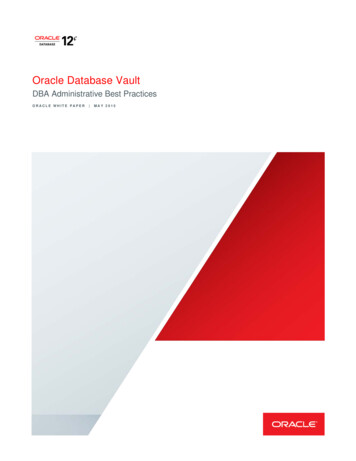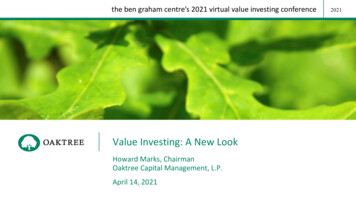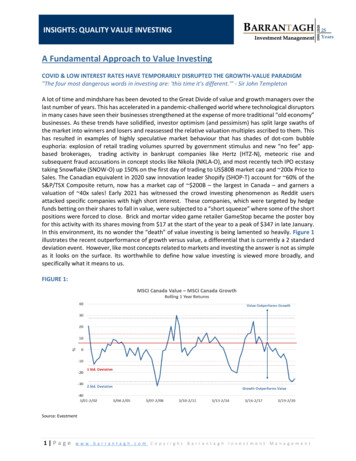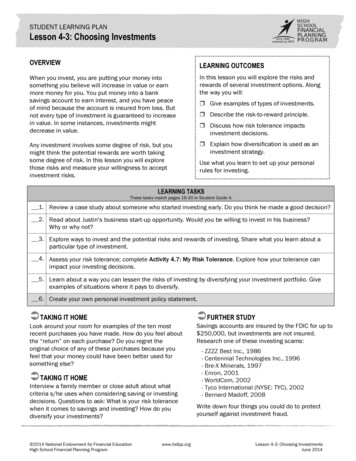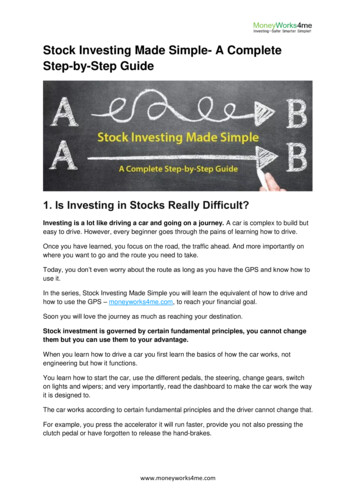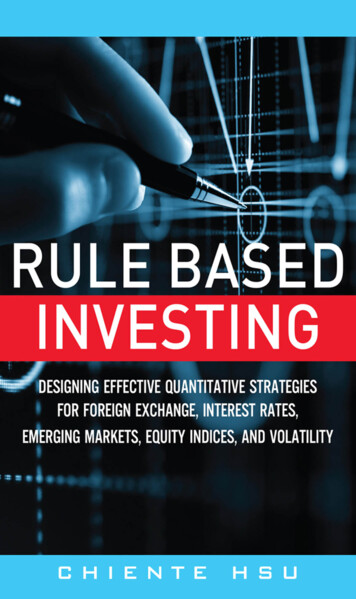
Transcription
Praise for Rule Based Investing“This excellent book presents very clear and understandable rules for mitigating the risks on investments designed to earn the risk premiums on volatility and ‘carry’ portfolios. As well known in academia and industry, a naïvestrategy of mechanically entering these investments offers a steady streamof small positive returns with occasional disastrously large negative returns.The book presents clear-cut, understandable, and sound sets of rules forattenuating the disasters but still earning nice average returns over time perunit risk. The book is quite suitable for undergraduate and master’s levelcourses. It should also be a convenient reference and practical guide foracademics and practitioners. The tables and figures are up to date, easy toread, and accompanied by a nice plain language narrative. Ms. Hsu’s extensive academic and industry experience makes her a superb choice to write abook like this one.”—George Tauchen, Glasson Professor of Economics, Duke University“In this challenging environment of low rates and fears of over-allocating toequities, investing professionals will be extremely interested in the strategiesthat Ms. Hsu has developed and refined over many years of working withsophisticated institutional clients. Her guiding principle, of earning risk premiums while protecting against large drawdowns, is simple, powerful, andpersuasive. I expect that the strategies in this book, while not for the faintof heart, will improve the risk-adjusted performance of many professionallymanaged portfolios.”—Bruce Tuckman, Clinical Professor of Finance, NYU Stern School ofBusiness, and author of Fixed Income Securities.“In Rule Based Investing, Chiente Hsu seamlessly blends rigorous academictheory and practical market knowledge. This is a uniquely informative andhighly readable book on systematic trading strategies for modern markets.”—Vineer Bhansali, Managing Director and Portfolio Manager, PIMCO9780133354348 Book 1.indb i11/21/13 3:05 PM
“We finally have a compendium to unveil the arcane ways of systematic, rulebased investment. In this book, Dr. Chiente Hsu walks the reader througha model portfolio with three independent rules based strategies. In doingso, she touches upon financial concepts, such as diversification, insurancepremium, volatility, tail risk, transaction costs, liquidity, carry, and momentum, with a pragmatism that testifies to years of market practice distilledby academic knowledge. This is achieved with simplicity and transparency.Sophisticated investors willing to learn about rule based investment will particularly enjoy it.”—Marcelo F. L. Castro, Partner and Portfolio Manager, Pharo Management“During the financial collapse of 2008, many systematic/quantitative investment approaches collapsed as volatility and correlations rose against them.Dr. Hsu demonstrates a variety of systematic strategies across different assetclasses that have proved their resilience since the beginning of the millennium through different market conditions, in an easy to understand andpragmatic way. This book is invaluable to students and financial practitionerswho want to investigate the quantitative side of investing.”—Andy Warwick, Managing Director and Portfolio Manager, BlackRock“Rule Based Investing endeavors to be a practical manual for serious investors seeking to tap essential systematic investment strategies to diversify andenhance portfolio results. Not only does the book exceed all expectationsin this regard, but it places itself at the vanguard of the practical revolutionsweeping the alternative investment space right now: systematic diversification across non-correlated, rule based trading strategies can be far superior,more transparent, and cheaper than elliptically described and mysteriousalpha strategies hawked by hedge fund gurus. With precision, clarity andaccessibility to ‘non-quants,’ Hsu lays out how rule based strategies achieveexcess returns, why there is a role for such strategies in the market, and whyrule-based investing’s excess returns will be sustainable in the future. Hsumasterfully combines intuitive illustrations, fundamental investment reasoning, and empirical analysis to explain key concepts and strategies. She convincingly makes the case that this exciting approach to investing provides animportant edge for portfolio managers seeking excess returns.”—Jim Conklin, Co-CIO and Director of Research, QFS Asset Management9780133354348 Book 1.indb ii11/21/13 3:05 PM
“In this enjoyable and readable text, Chiente Hsu explores the idea of letting a set of rules dictate exit of various strategies collecting risk premia invarious corners of the market. This exit discipline already can go a long way,even before applying judgment, because it helps in the most important decision of investment: when to not be involved. If you are successful at avoidingcrisis (when diversification fails), she goes on to show how you are left withthe periods where it works very well indeed.”—Jean-Marc Bottazzi, Partner, Capula“Chiente Hsu has a unique perspective that blends quantitative disciplinewith practical reasoning. She lays out the simple rules for investing in a clinical approach that avoids the emotional entrapment of the market. Dr. Hsunot only explains fear in the market—she demonstrates how to profit from it.A must read for any investor.”—Molly Duffy, Managing Director, Credit Suisse“Chiente does an excellent job distilling complex quant strategies into simplerules. From idea formation to risk management to trade implementation,the book provides a valuable framework for developing investment strategiesthat should benefit both discretionary investors and quants.”—Jia Ye, Partner, First Quadrant“Rule Based Investing is a remarkable book that allows non-experts to understand key market topics such as volatility, carry or momentum strategy. Allthese issues are covered in a simple and readable fashion without using complicated models and equations.”—Stefano Natella, Co-Head Global Secuturities Research and Analytics,Credit Suisse“Chiente Hsu’s Rule Based Investing will be of great help to many investors,portfolio managers, and traders. I worked closely with Chiente. She alwaysimpressed some of the world’s largest asset managers and their decisionmakers about her quantitative approach. It was a great pleasure and honorto have worked with Chiente, a true professional in a very complex world ofcreating true alpha and performance.”—Martin Wiedmann, Global Head of FX Sales & Distribution CreditSuisse (2008-2012)9780133354348 Book 1.indb iii11/21/13 3:05 PM
This page intentionally left blank
Rule Based Investing9780133354348 Book 1.indb v11/21/13 3:05 PM
This page intentionally left blank
Rule Based InvestingDesigning Effective QuantitativeStrategies for Foreign Exchange,Interest Rates, Emerging Markets,Equity Indices, and VolatilityChiente Hsu9780133354348 Book 1.indb vii11/21/13 3:05 PM
Vice President, Publisher: Tim MooreAssociate Publisher and Director of Marketing: Amy NeidlingerExecutive Editor/Acquisitions Editor: Jeanne Glasser LevineDevelopment Editor: Natasha TorresOperations Specialist: Jodi KemperMarketing Managers: Megan Graue, Lisa LoftusCover Designer: Chuti PrasertsithManaging Editor: Kristy HartProject Editor: Katie MatejkaCopy Editor: Language Logistics, Chrissy White; Barbara HachaProofreader: Jess DeGabrieleIndexer: Tim WrightCompositor: Nonie RatcliffManufacturing Buyer: Dan Uhrig 2014 by Pearson Education, Inc.Publishing as FT PressUpper Saddle River, New Jersey 07458This book is sold with the understanding that neither the author nor the publisheris engaged in rendering legal, accounting, or other professional services or advice bypublishing this book. Each individual situation is unique. Thus, if legal or financialadvice or other expert assistance is required in a specific situation, the services of acompetent professional should be sought to ensure that the situation has been evaluated carefully and appropriately. The author and the publisher disclaim any liability,loss, or risk resulting directly or indirectly, from the use or application of any of thecontents of this book.FT Press offers excellent discounts on this book when ordered in quantity for bulkpurchases or special sales. For more information, please contact U.S. Corporate andGovernment Sales, 1-800-382-3419, corpsales@pearsontechgroup.com. For sales outsidethe U.S., please contact International Sales at international@pearsoned.com.Company and product names mentioned herein are the trademarks or registered trademarks of their respective owners.All rights reserved. No part of this book may be reproduced, in any form or by anymeans, without permission in writing from the publisher.Printed in the United States of AmericaFirst Printing December 2014ISBN-10: 0-13-335434-2ISBN-13: 978-0-13-335434-8Pearson Education LTD.Pearson Education Australia PTY, Limited.Pearson Education Singapore, Pte. Ltd.Pearson Education Asia, Ltd.Pearson Education Canada, Ltd.Pearson Educación de Mexico, S.A. de C.V.Pearson Education—JapanPearson Education Malaysia, Pte. Ltd.Library of Congress Control Number: 20139510059780133354348 Book 1.indb viii11/21/13 3:05 PM
This book is dedicated toMaeya, Nalla, and Nicolas.9780133354348 Book 1.indb ix11/21/13 3:05 PM
ContentsIntroduction . . . . . . . . . . . . . . . . . . . . . . . . . . . . . . . . . . . 1Chapter 1Rule Based Volatility Investment . . . . . . . . . . . . . . . . . . . 9Learning to Love Volatility . . . . . . . . . . . . . . . . . . . . . . . . . 9Volatility in Capital Markets . . . . . . . . . . . . . . . . . . 13Investing in Volatility Through Rules . . . . . . . . . . . 17Profiting from Volatility and Awarenessof the Danger . . . . . . . . . . . . . . . . . . . . . . . . . . . . . . 19The Examples of Rule Based VolInvestments . . . . . . . . . . . . . . . . . . . . . . . . . . . . . . . 26Building a Volatility Portfolio . . . . . . . . . . . . . . . . . 68Some Remarks . . . . . . . . . . . . . . . . . . . . . . . . . . . . . 76Chapter 2Rule Based Carry and Momentum Investment. . . . . . . 79Rule Based Carry Investment . . . . . . . . . . . . . . . . . . . . . . 79“Benchmark” Returns in the FXCarry Trade . . . . . . . . . . . . . . . . . . . . . . . . . . . . . . . 83The Risks of the FX Carry Trade . . . . . . . . . . . . . . 89The Steam Roller . . . . . . . . . . . . . . . . . . . . . . . . . . . 89Simple yet Effective Rules forCarry Investment . . . . . . . . . . . . . . . . . . . . . . . . . . . 94Some Remarks . . . . . . . . . . . . . . . . . . . . . . . . . . . . 107Chapter 3Rule Based Value Investment . . . . . . . . . . . . . . . . . . . 109Value in Emerging Markets. . . . . . . . . . . . . . . . . . . . . . . 109Value Investing in Emerging Market FX . . . . . . . . . . . . 115Rule Based Investment in EmergingMarket FX . . . . . . . . . . . . . . . . . . . . . . . . . . . . . . . 118Fundamental Rules . . . . . . . . . . . . . . . . . . . . . . . . . . . . . 121Technical Rules: Overlaying CreditDefault Swap Spread as Market Indicator . . . . . . 126Combining Fundamental Rulesand Risk Indicators . . . . . . . . . . . . . . . . . . . . . . . . 1309780133354348 Book 1.indb x11/21/13 3:05 PM
CONTENTSxiValue Investing in Emerging MarketSovereign Bonds . . . . . . . . . . . . . . . . . . . . . . . . . . . . . . . 134Fundamental Rules . . . . . . . . . . . . . . . . . . . . . . . . 135Technical Rules . . . . . . . . . . . . . . . . . . . . . . . . . . . 139Combination of Macro Fundamentals andMarket Indicator . . . . . . . . . . . . . . . . . . . . . . . . . . 141Some Remarks . . . . . . . . . . . . . . . . . . . . . . . . . . . . . . . . . 147Chapter 4Rule Based Portfolio . . . . . . . . . . . . . . . . . . . . . . . . . . . 149The Next Crisis and Beyond . . . . . . . . . . . . . . . . . . . . . . 157Bibliography . . . . . . . . . . . . . . . . . . . . . . . . . . . . . . . . . 161Index . . . . . . . . . . . . . . . . . . . . . . . . . . . . . . . . . . . . . . . 1659780133354348 Book 1.indb xi11/21/13 3:05 PM
AcknowledgmentsI wish to thank Bruce Tuckman, without whom this book wouldnot be possible. Bruce has been my mentor since day one of my investment banking career. From Bruce I learned not to sacrifice intellector morals in the fast moving world of finance.I wish to thank George Tauchen from whom I’ve learned financial econometrics, and I continue learning from him. All mistakes inthe book of course are my responsibility alone.I wish to thank my colleagues and teammates at Credit Suisse. Iwas fortunate to be given the support and vote of confidence to run aquant team full of hard working talent.I wish to thanks Adam Esperidiao, a brilliant inventor and entrepreneur. Adam has been key in making technical subjects accessible to a broad public audience. I look forward to our continuedcollaboration.Finally, I wish to thank my husband Nicolas Sagna, whose unconditional love makes me the luckiest person and blesses my life.9780133354348 Book 1.indb xii11/21/13 3:05 PM
About the AuthorChiente Hsu (New York, NY) is the founder of Alpha SystemAdvisors, LLC. She was Managing Director and global head of AlphaStrategies at Credit Suisse. From 1998 to 2012, she led a team ofPh.Ds implementing quantitative investment strategies for investors,which included asset management, pension funds, corporates andhedge funds. Dr. Hsu was previously a professor at the University ofVienna, Austria, and a visiting professor at Duke University in NorthCarolina, teaching and conducting research in financial econometrics.She has published widely in major finance and economics journals,such as The Review of Economics and Statistics. Dr. Hsu holds an MAin Computer Science and Business Management from the TechnicalUniversity Vienna and a Ph.D in Economics from the University ofVienna, Austria.9780133354348 Book 1.indb xiii11/21/13 3:05 PM
This page intentionally left blank
Introduction“Before a person studies Zen, mountains are mountains andwaters are waters; after a first glimpse into the truth of Zen,mountains are no longer mountains and waters are not waters; after enlightenment, mountains are once again mountains and waters once again waters.”—Ch’ing-yüan Wei-hsinThe purpose of this book is to rediscover simple, scientificallysound investing. It has taken me the better part of my adult life spentdesigning and implementing complex trading strategies, both in academia and on Wall Street, to recognize simplicity. Years spent studying trades that consistently make money reveal simple truths behindtheir success, essential rules that winning strategies follow. Moreimportant than the intricacies of the models or parameters used,are certain fundamental principles we reduce to essential questions:Do we understand the source of the persistent returns? How do wedecide when to take risk? Does the model take into account price history? Are forward-looking indicators filtering the trading decisions?Are we maximizing diversification?Experience teaches that market expertise only goes so far, anda simple strategy broadly applied across diverse uncorrelated markets provides better protection against crisis events. Having analyzedreams of market data as only fellow “quants” can understand, we avoidthe perils of “data mining” with simple “risk on/risk off” rules, sparinguse of historical data and real-time indicators of market sentiment.Investors have long been told to simply “buy and hold” stock indices,19780133354348 Book 1.indb 111/21/13 3:05 PM
2RULE BASED INVESTINGthat it’s impossible to time the market, and that the trading fees alonewould bleed you dry.The truth is in the middle. “Buy-and-hold” is a simple yet riskystrategy that experiences losses during crisis events. A trading strategy that is revisited monthly does not incur the excessive costs thatdoom “day trading” and is much more reactive to market realities andchanges than a completely passive strategy of buy and forget. It isimpossible to time market highs and lows, but it is possible as well asextremely prudent to gauge market anxieties and turn risk off whentrouble threatens. The profound improvement produced by applyingthese rules might seem like voodoo or a glitch unique to the historicaldata (“fool’s gold” from data mining), but it comes from extending tothe financial market the same intuition we practice in everyday life.If the weather is overcast and cloudy, it does not guarantee a storm iscoming, yet all the same, why take the risk of sailing on that day?Arriving at this perspective required the accumulation of enormous human capital in the form of collaboration with many Ph.D.sover the years. In these think tanks of professionals with strong academic backgrounds, we sought always a firm grounding for why atrade makes money as well as the question of how much money itcan make. Throughout my career I’ve continued to follow academicresearch to provide a better understanding of the science behindinvesting, drawing from theory before putting a strategy into practice in managing assets. Science moves forward from a combinationof theory and practice: It is the work of theoretical physicists thatinforms experimental physicists “where to look” for interesting resultsin the natural world. We can view finance in the same light, drawingfrom academia the fresh ideas that inform better models and strategies. The final product of this knowledge and experience is a rulebased framework of principles easily translated across asset classes formaximum diversification.From simple rules profound changes arise. The improving safetyrecord of the aviation industry arose after the application of rules and9780133354348 Book 1.indb 211/21/13 3:05 PM
INTRODUCTION3checklists for inspections and safety procedures before takeoff andlanding. Improved metrological science keeps planes grounded whenthe threat of severe weather arises. Equally in medicine, implementing rules and checklists for sanitization and sterilization of hands andtools prior to surgery profoundly reduced incidents of infection onceconsidered a natural part of healing. Through basic boilerplater investment advice, investors are taught that the “buy-and-hold” strategy isbest, that the S&P 500 is the ultimate benchmark, and that there isno alternative but to accept heavy losses during crisis events—all ofwhich are insufficient in light of rule based strategies.You might be skeptical that if something so simple is so effective, why isn’t this already widely known? Just as consumer goods aredesigned with a limited useful life, a “planned obsolescence” whereproducts fail or become unfashionable after a few years, the financialindustry benefits from obfuscation. In the financial world seldom isanything described as “simple”; from the industry jargon to the information overload of stock tickers, the financial industry is a cloisteredworld. Behind the groomed esotericism is the suggestion that thosewithin the industry are privy to secrets others are not.Fortunately this book is accessible not only to financial professionals, but anyone with an interest in objective rule based investing styles. Throughout the text, technical discussions of equations areavoided as much as possible (they are available, however, in the bibliography for those interested), and the focus instead is on buildingthe intuition that informs a rule based system. The purpose of thisbook is to demonstrate to investors that simple rules, when built onsound scientific principles and divorced from emotions, are capableof notable results.In the financial world it is difficult to differentiate good advicefrom mediocre advice from utterly incorrect advice. The bar for“decent returns” is typically considered to be the S&P 500. This intuitive faith that equity indices progressively reach ever new highs is anexample of the phenomenon of persistent returns. It is true that in9780133354348 Book 1.indb 311/21/13 3:05 PM
4RULE BASED INVESTINGthe long term indices grow because the population is growing, businesses are becoming more efficient and more innovative everyday,and opportunities continue to multiply. Civilization is generally acycle of positive reinforcement and improvement.The issue is then how to best capture that persistent return.The buy-and-hold strategy can work in the long run, but it is a riskystrategy with volatile returns and significant exposure to extrememarket events. In looking to move beyond buy-and-hold, there havebeen many suggestions and theories, often complicated and without grounding, of finding patterns in historical data to predict futuremovement. That would be an example of data mining, as it is easy tofind patterns in existing data that are irrelevant to predicting futureprice movements.There are other examples of markets exhibiting persistent returnsthat we explore together in assembling a globally diverse rule basedportfolio. In volatility markets we take a look at how receiving volatility premium is a consistently profitable position analogous to the longterm success of insurance companies. Emerging market economiesexhibit strong growth as revealed by GDP growth and other economicmeasure, which are better captured through currencies and bondsrather than equity markets. Rules are discussed for improving thecarry trade among G10 currencies.Moving beyond passive investment and the perils of data mining, you learn that you must take historical data into account onlyto a limited first-order degree. In the case of volatility investing, anintelligent measure of the moving average, GARCH, is used as a rulefor filtering risk. In the currency carry investing, diversification is thekey to persistent returns, and in value investing a ranking of macroeconomic fundamentals is used to determine the “value” of emergingmarket countries.Investment decisions are further filtered by forward-looking market indicators. For the carry trade and volatility investing, you learn touse the VIX, the “fear barometer” of the market, to gauge the anxiety9780133354348 Book 1.indb 411/21/13 3:05 PM
INTRODUCTION5level over future months. In interest rates you can use the shape of thevolatility curve to establish forward-looking rules. In emerging markets you can use real-time information from the credit default swap(CDS) markets to determine the market’s current view of a country’scredit worthiness.The philosophy of the rules is the same: History, in the form ofstatistics, provides relevant background information that is furtherrefined by the forward-looking information of market prices (suchas the VIX, slope of the volatility curve, and CDS spreads). Technical rules derived from price action only are vital, but fundamentaleconomics are not dead, as you discover in this book’s discussion ofvalue investing rules. The most powerful rules, as is demonstratedthroughout, are produced by combining both historical and forwardlooking filters. The strength of the complete portfolio assembled hereis scientifically founded in the diversification provided by widely different asset classes. Risk is spread out among markets as unique fromeach other as G10 currencies, emerging market bonds, and volatility markets. Risk is spread out via distinct investment styles such asvolatility, carry, and value investment. Not only do the returns of thesample portfolio provided in this book dwarf those of equity markets,the volatility is remarkably low, making for intelligent and profitableinvestments.Throughout the book you are given examples based on similarinvestment guidelines, such as low frequency trading, where yourevisit your investment decisions on a monthly basis, minimizing theconcern of transaction costs. The investments to take on are longterm profitable and well understood in exhibiting a persistent premium, such as volatility premium, carry premium, and emergingmarket growth. There’s no getting away from the fact there is potential danger in these investments, such as severe losses during a marketcrisis event, and you learn how to use forward-looking market pricesin the forms of VIX, credit default swap spreads, or the shape of thevolatility curve to filter out the worst of these events and reduce their9780133354348 Book 1.indb 511/21/13 3:05 PM
6RULE BASED INVESTINGimpact. The market indicators alert you to heightened fears of potential turmoil, and during those months you should reduce risk ratherthan gamble on the outcome of extreme events.After years spent in academia researching Financial Econometrics, followed by 15 years in investment banking developing quantitative investment strategies, the end result of having designed countlessfinancial models and trading programs has been to revisit the basics ofinvestment with a new set of eyes that recognize the salience of simpletruths expressed in simple rules. To quote T.S. Eliot, “We shall notcease from exploration / And the end of all our exploring / Will be toarrive where we started / And know the place for the first time.” Theseinsights into a new rule based system of investing are the crystallization of my professional experience, derived from the certainty thatavoiding emotion-driven decisions through informed and scientificrules produces the best and most intelligent long-term investments.This book only scratches the surface of rule based strategiesthrough a few examples. There are many other investment possibilities, and every day the number grows as academic research helps us tounderstand market interactions and causalities that lead to the designof better and more robust rules. Exciting examples mentioned hereuse model free volatility/variance premium to predict future returnsas well as research that aims to explain and price the carry risk premium. The strategies introduced in this text can be refined for greatereffectiveness as well as expanded to cover additional asset classes andmarkets. Furthermore, in the future publications I hope to explore toa greater depth the ability of rule based systems to signal and hedgeagainst rare and dreaded “black swan” events.The simplicity of these rules is also a humble acknowledgementof the unknowable chaos that churns the tides of the financial markets. How we choose to “ride the chaos” so to speak, is a challenge wemust approach from the perspective of a surfer. Surfing is, after all,an apt representation of individual grace and control while balancedon the edge of the unfathomable turbulence that fathers big waves.9780133354348 Book 1.indb 611/21/13 3:05 PM
INTRODUCTION7Inexperienced surfers are liable to exhaust themselves in a futilechase after every minor ripple that comes along, not unlike day traders, while still others, afraid of engaging the water might drift aboutpassively behind the breakers to no avail. A seasoned surfer, however,is informed by both his ingrained experience of the beach as well asby keeping sharp eye always on the horizon, filtering out dozens if nothundreds of potential swells before the ideal wave is chosen. Withthe right wave selected, disciplined muscles engage, and from a seaof unpredictability there arises a graceful figure sailing the crest offoaming waters. A wise surfer is one who has learned that when badweather threatens out in the distance, whether there will actually be astorm or not, he watches the ocean from the shore that day. Basic andintuitive truths reveal themselves in the simplest rules.9780133354348 Book 1.indb 711/21/13 3:05 PM
This page intentionally left blank
1Rule Based Volatility InvestmentLearning to Love Volatility“Investing in volatility” might seem a contradictory phrase.Semantically we tend to equate volatility with unpredictability andchaos, precisely the abstract forces that foil most investment strategies. It is not intuitive to think of volatility as something innatelyvaluable, nor to recognize volatility as a rich and unique asset class.Even many experienced financial professionals comfortable readingan earnings report think of volatility markets as an esoteric technical subject better left to options traders. Underlying complex mathematical pricing models, however, are intuitive market principles thatexplain why a “volatility premium” exists and how it can greatly benefit most portfolios.Stocks are commonly understood as owning a share of a company,treasuries as a loan to the government, and commodities as durablephysical goods, but what is the underlying value of volatility? Beforeinvesting in volatility, it’s crucial to understand on a fundamentallevel where the potential profit comes from and why. Volatility andoptions are already subjects that are unfamiliar and intimidating tomany, and there’s no shortage of options traders and fund managerswho will default to explanations involving the Black Scholes modeland Greek variables of options trading. The result is the impressionthat making money through volatility is on par with theoretical physics99780133354348 Book 1.indb 911/21/13 3:05 PM
10RULE BASED INVESTINGrather than the application of basic market principles. Understandingthat heat will spread through a spoon from one end to the other doesnot require solving the heat diffusion equations. Visualizing spacetime as a stretched blanket in which masses such as planets cause asag doesn’t demand a doctoral degree. Equally understanding that,on average, selling volatility is a profitable strategy requires only therecognition that investors will always be willing to pay for protectionagainst uncertainty.The “volatility premium” exists because of investor fear. The origins of futures exchanges began with farmers seeking protection fromcommodity price swings through future contracts. The farmer is guaranteed a fixed price for his harvest months in advance. The speculator receives the unknown “floating” price of the harvest at a futuredate. The speculator stands to profit if on the con
premium, volatility, tail risk, transaction costs, liquidity, carry, and momen-tum, with a pragmatism that testifies to years of market practice distilled by academic knowledge. This is achieved with simplicity
